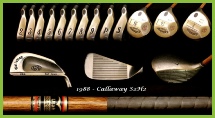
COMPANY HISTORY:
Callaway Golf Company is a global sporting goods company that designs, manufactures, markets and sells golf equipment, golf accessories and golf lifestyle-related products in more than 70 countries worldwide. The American company, based in Carlsbad, California, is the world’s largest maker of golf clubs.
Callaway Golf sells its products through golf retailers and sporting goods retailers, through mass merchants, directly online, and through its pre-owned and trade-in services. Callaway Golf licenses its name, trademarks and service marks for golf lifestyle products including golf apparel, golf shoes, golf bags, headwear, watches, rangefinders, practice aids and travel gear.
Callaway Golf also market products under the Odyssey putter brand, acquired in 1997, as well as the Top-Flite, Strata and Ben Hogan golf brands picked up following the bankruptcy of Spalding's former golf division in 2003.
History
Callaway Golf Company was founded by former Burlington Industries textile president, Ely Callaway Jr. Callaway was raised in Lagrange, GA and was a graduate from Emory University. Callaway became very successful in the textile industry and was very fond of playing golf. At games, Callaway would use clubs by Hickory Sticks. The clubs were constructed of hickory-shafts with a steel core. At that time, Hickory Sticks was owned by Richard Parente, Dick De La Cruz and Tony Manzoni. As Hickory Sticks started running low on funds, they sought investors to help the company and approached Callaway. At the time, he had just sold his vineyards for a $9 million profit. Then in 1982, he bought half of Hickory Sticks, the company was renamed to Callaway Hickory Stick USA. In 1984, Callaway bought the rest of the company for $400,000. In 1983, he became president and moved the company to Carlsbad, California where he sold clubs out of his Cadillac. The company eventually changed to its present name in 1988. In 1985, the company hired Bruce Parker, as head of sales, who later became the company's Chief Merchant and through his tenure with Callaway Golf as head of sales was responsible for sales in excess of $3.0 billion. As a key member of management, Parker was involved in all major decisions during the company's growth.
In 1986, Callaway hired a billiard cue designer, Richard C. Helmstetter, as a consultant. Helmstetter later became chief club designer that same year and introduced computer-controlled manufacturing machines. With his help and the help of Glenn Schmidt, the company's master tool maker, the company developed the original Big Bertha driver using large-volume (190cc) steel clubhead. The Big Bertha driver grew to 290 cc in 1997.
In 1996, the company hired Roger Cleveland as chief club designer and in 2002, launched the Callaway Golf Forged Wedges. These wedges were constructed from carbon steel and a face with modified U grooves.
In that same year, Callaway announced the development of a new golf ball, under the leadership of Chuck Yash, the former head of Taylormade Golf. Callaway Golf spent three years developing its new golf ball and a state-of-the-art production facility. The company’s entry into the market represented a $170 million investment in the research and development of the ball, construction of the 225,000-square-foot (20,900 m2) production facility, and development and purchase of special manufacturing equipment. Callaway’s manufacturing facility and its equipment were designed specifically for the unique production requirements for the new ball.
Callaway Golf Ball Company engineers, recruited from Du Pont and Boeing, used aerodynamic computer programs (first used by Boeing and General Electric) to evaluate more than 300 dimple patterns and more than 1,000 variations of ball cores, boundary layers, and cover materials to create the new Rule 35 ball. Callaway engineers designed only two models of the Rule 35 ball—choosing to develop a "complete-performance" ball rather than separate balls developed for spin, control, distance, and durability. Ely Callaway explained the company’s product development objectives as follows: "We have combined all of the performance benefits into one ball so players no longer need to sacrifice control for distance, or feel, or durability. Each Rule 35 ball contains a unique synergy of distance, control, spin, feel and durability characteristics. This eliminates confusion and guesswork in trying to identify the golf ball that is right for each individual golfer."
In 1997, Odyssey Sports was acquired expanding Callaway's line of putters. This eventually led to the release of the Odyssey White Hot putter line in 2000.
Ely Callaway resigned as CEO and President in 1996 stepping aside for Donald H. Dye to take over as CEO and President, but Callaway continued to be an integral part of the company as Chairman of the Board and as President and CEO of Callaway Golf Ball Company and in a promotional role for all of Callaway's products. He later returned in 1998 to reassume his position as President and CEO of Callaway Golf Company but died of pancreatic cancer on July 5, 2001 which left the position to Ron Drapeau.
In 2003, Ron Drapeau, announced the intended purchase of Top-Flite Golf, as well as its Ben Hogan Golf division, soon after it filed for Chapter 11. Following competition from Adidas the acquisition would eventually cost Callaway Golf $169 million.

